Q&A – Ask Neil: October 24, 2024
(Please read these instructions carefully.)
Before you post your question, please look at recent issues to see if someone else has already asked it. You might find your answer there.
How to submit your question…
(Note: You may need to allow a pop-up window to come up in order to get the link for sending your photo(s). If you have already submitted your question and didn’t see the pop-up window, please click here.)
• Click the link provided below to post your question. After you submit your question, a new window will pop up giving you the address to which you can e-mail a SHARP, HIGH-RESOLUTION PHOTO to accompany your question. Please DO NOT SEND THUMBNAIL PHOTOS in case I need to zoom in to see things.
• Click here to post your question.
• Please ONLY POST YOUR QUESTION ONE TIME. We can only accept a set number of questions each week, and when we get duplicates it costs other people their chances.
• One question per reader, please.
• Please use this only for posting questions – not for standard emails.
• Watch for your answer in the following week’s e-gardens.
• I choose those of greatest general interest. For example, plant IDs seldom make the cut.
• I must have your first name or initials.
• I must have your city or county. (Texas is a very large state.)
QUESTION 1
WHAT IS THE PROGNOSIS FOR OUR OAK TREE?
Question: We have a gorgeous oak tree in our front lawn. I am extremely worried about it. Mushrooms are growing at its base on every side. Otherwise, the tree looks healthy. Is there a treatment or is it on its way out? Lynne S., Athens.
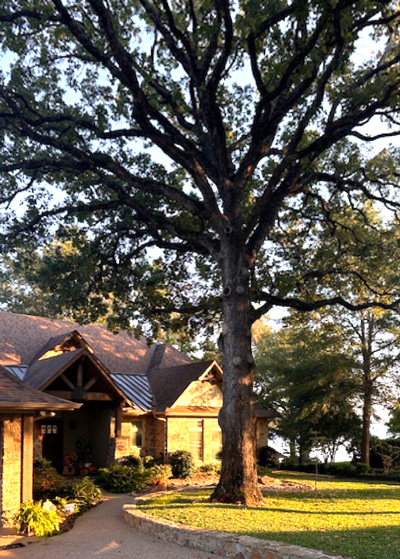
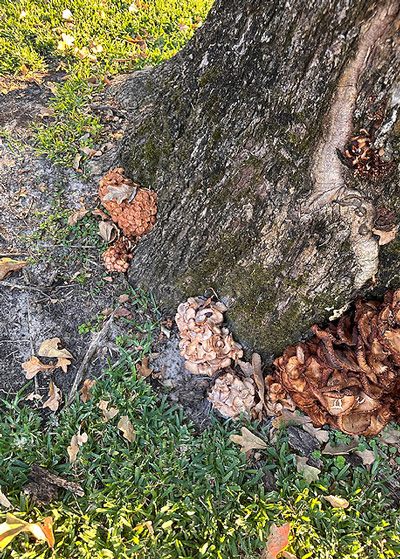
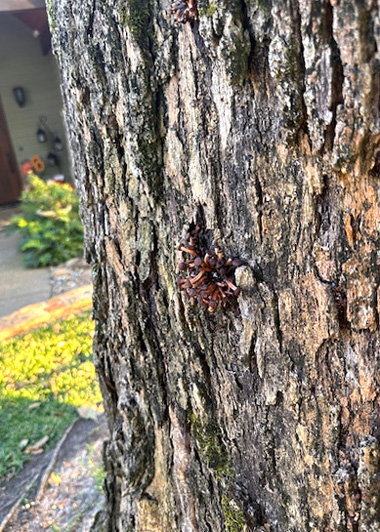

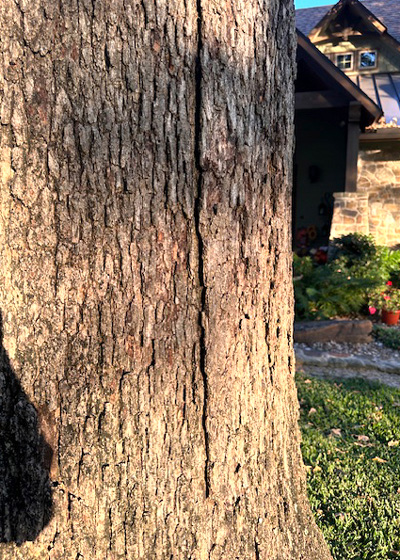
Answer: I’m not happy to deliver this message. It is so good that you are concerned because your tree is in serious jeopardy. Mushroom growths like this develop from wood-rotting funguses within the interior of the trunks of infected trees. Often, they are the only symptoms we see until it’s too late. The supportive wood of the interior of the trunk softens with the decay and the tree eventually falls during a wind or ice storm or just from its own weight.
Sometimes these growths take the form of brackets or shelf-like extensions, often appearing to be varnished. Yours are more jumbled than many, so if you Google the term “conk” regarding oak trees and see images unlike your own do not be surprised.
You need to get a certified arborist on site as quickly as you can. To say it again, this tree will eventually fall, whether it’s within a few months or a year or two. As completely as the trunk is involved, I would not delay. You will see that the bark has darkened areas, probably due to decayed wood close inside.
QUESTION 2
WHAT IS GROWING IN MY SAUCER MAGNOLIA?
Question: What is growing in my saucer magnolia? Last year it had those beautiful pink and white blooms and it’s doing well. However, this year it has these huge leaves that seem to be growing out from the base of the tree. What is it? Cindy M., Spring.
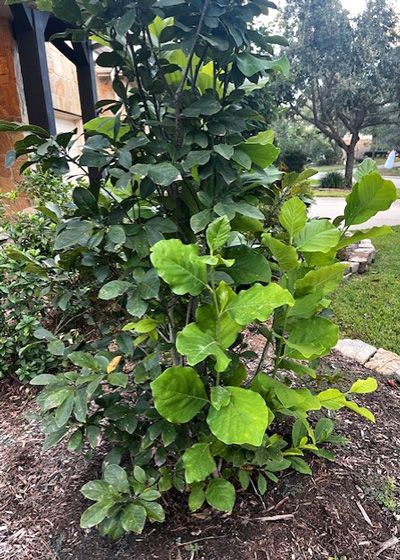
Answer: You and I are going to have to work on this answer together.
My assumption is that you are seeing leaves from the rootstock of your saucer magnolia. The varieties sold in nurseries are grafted onto other rootstocks to speed propagation and to allow us to have the beautiful, improved cultivars like yours. When a rootstock takes it upon itself to sprout out new shoots and start growing, it will often do so with great vigor. That’s why the new shoots grew so rapidly, and the fact that it wasn’t genetically exactly the same as the cultivar you bought explains why the leaves might look different.
As I said, that’s my assumption. Where your part comes in: you need to trace one of those rogue shoots down to where it joins the trunk. You should be able to see where the graft was made, and you’ll be able to tell if these new shoots originated from below that point. If so, they are the rootstock and not the variety you bought. If that’s the case, you would want to prune them off and keep them from returning. They will rob nutrients and water from the improved variety you bought.
I have an ‘Autumn Gold’ ginkgo that has been outside my office at home for 35 years. It, too, is grafted, and for all of those 35 years I’ve had to trim off similar sprouts every spring.
QUESTION 3
HOW SHOULD I PRUNE MY JAPANESE MAPLE?
Question: I recently “transplanted” my Japanese maple a couple of feet closer to the house – out of harm’s way from the summer’s afternoon sun. Now the top has died. How do I prune the top? Barbara B., Denton.


Answer: I wish I could ask questions back before I attempted my answer. You put “transplanting” in quotes. If you dug it and moved it, you did transplant it. That should always be done in mid-winter while a plant is dormant. If the top died after the move, that could have been the cause. Or it might have been dead before you moved it.
But that wasn’t what you asked. You would start by pruning anything that is obviously dead. There is no point in leaving dead wood in place. Then you look at the tree and decide whether you need to do additional pruning to reshape it. You don’t want a bunch of branches coming up from way down low on the trunk. In fact, you need to be careful to leave only branches that are above the graft union. (See previous question.)
I do worry that you don’t have a spot on this corner of your house that is going to be the total shade that Japanese maples need. If it was sunburning 2 ft. farther out, it surely does look like the sun will still be able to hit its leaves. Do you possibly have a place on the opposite side of your home where it might get shade all day long during the summer? If so, I would move it again this winter.
QUESTION 4
WHAT IS WRONG WITH MY DWARF NANDINAS?
Question: I’ve had dwarf nandinas in my yard for years. They have always been healthy but now most of them have started to thin out and many of their leaves are yellowing. What can I do? Carole T., Austin.
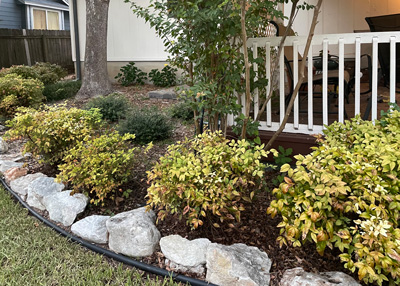
Answer: This is iron deficiency due to your extremely alkaline soils and irrigation water. Begin by applying an iron additive along with a sulfur soil acidifier. You’ll get better results in the spring when they’re gearing up to grow, but you could try it now. Warning: keep iron products off the limestone rocks. They can give a rust-colored stain. It might be a good idea to lay plastic over the stones before you make the treatment. You could even use a liquid iron product as a spray onto the foliage. Just keep it away from anything that could be stained, the white wood included.
For what it’s worth, Nana nandinas and others with the broad leaves like yours have always seemed to be more prone to iron deficiency than Harbour Dwarf and other dwarfs with its more normal, smaller leaves. I also have alkaline soil and have had the same experience you’ve had, and Harbour Dwarf, Harbor Belle, and Flirt nandinas have all been superior for me. They’re gorgeous, and I’ve never seen any iron deficiency on mine.
QUESTION 5
WHAT KILLED MY BURFORD HOLLY?
Question: Attached are photos of a black circular insect that appears to have killed my Burford holly one branch at a time. They can be flicked off with my fingernail. What can I use to kill it? Cindy P., College Station.
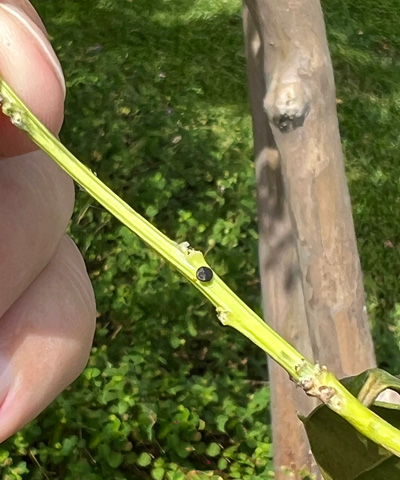
Answer: That appears to be some type of scale insect, but it’s not one that commonly attacks Burford holly. From the population I can see in your photos, I can’t believe that there are/were enough to kill even one branch.
Is there any chance that this plant got too dry at least one time? Hollies don’t wilt, and it’s easy to let them slip past the point of no return (“permanent wilting point”) without realizing it. Sadly, I’ve seen hundreds in that plight in the past three months.
Double check other branches to see if there are any that are still alive that also have this insect, especially if you have another Burford holly plant nearby. And see if you have much greater populations somewhere else on this plant where a branch has not died.
QUESTION 6
SHOULD I PRUNE THIS DEVIL’S BACKBONE?
Question: I found this devil’s backbone plant after you recommended it two years ago. Should I prune it back or just repot it into a larger pot? How would I prune it? Terry C., Dennis (Parker County).
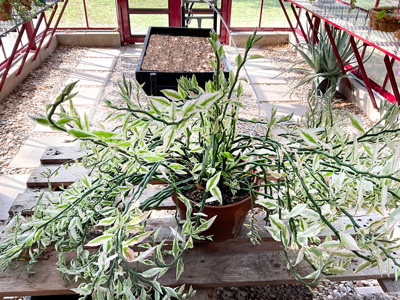
Answer: You really made my day. It’s absolutely beautiful. Well done! I would repot it into a larger terra cotta pot (for the extra weight to act as a ballast). Then I would set it up on an inverted clay pot so those lovely branches could spread to the sides. There will be new shoots coming up out of the center of the plant. They will be strong, straight, and very vigorous. At that point, probably mid-spring, you can decide what you want to do with the mother plant. You could remove a couple of the lowest branches at that point and root them as cuttings to get new plants to give to your friends. They’ll love having them!
